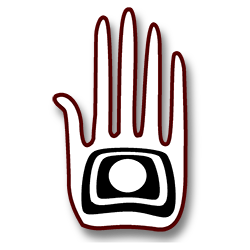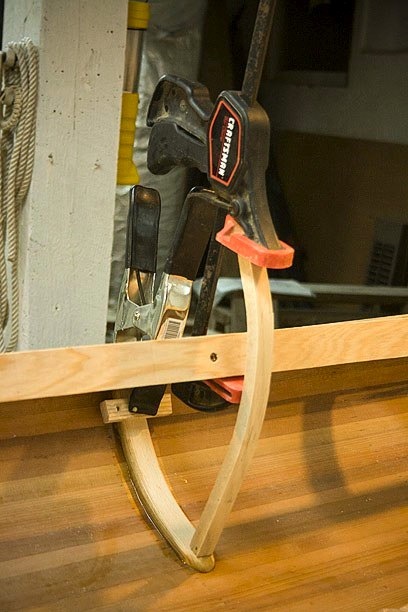 South, with bentwood Ribs and Knees.
South, with bentwood Ribs and Knees.
Knees, Ribs, Breasthooks, Cockpits . . . these are boats we’re building, right?
Ribs and Knees are now installed in South. North has its Ribs clamped up while the epoxy sets, and will get Knees this weekend. It took a tremendous amount of work to make these little features, but they’ve turned out really well, and I’m very pleased.
I wasn’t convinced I would need Knees at all, but other builders I talked to thought it was risky to do without. Technically, they support the side decks and help resist twisting in the hull. With other building styles, particularly those that use only screws or nails as fasteners, knees are an absolute necessity, as the planks would eventually work themselves apart. In rigid composite construction they’re less common, and smaller designs dispense with knees, and even framing, altogether. With everything screwed and glued in place, this framing is already very stiff without Knees, and the coaming trim and deck will stiffen it yet more. I almost decided to do without, even though I had already bent all the pieces. Regardless, it will be useful having braces to lash the oars against, and they add an interesting design element. Now that they’re installed, the boats are extremely rigid. I’ll think of it as insurance.
Installation was really, really tricky. Spacing, angles, attachment, adjustment – all of it took hours of planning and thinking. Even after sorting all the pieces according to size and curvature, almost all the ribs took a little fine tuning with a heat gun to seat just right and conform to the curve of the hull. Then every piece was shaped and smoothed on the belt sander.
The Ribs go in first. These aren’t truly Ribs, which would run all the way from sheer to keel. These short Ribs primarily form a base to support the Knees. But they’re are in the same location and have a similar, though more limited, function. And they sure look like ribs.
It took some creative clamping to hold them firmly in place while the epoxy set – there are no screws, glue only. Some of the broken wood-bending pieces came in handy for this.
Creative clamping.
All Ribs clamped in place.
Finished Ribs.
With the epoxy fully cured, the clamps could come off and the Knees go in their place. Attaching the Knees to the frames was a bit kludgy. The slender pieces of Ash are too small for a screw through the side into a frame. If I were to do this again, I would marry sister frames together, with one scribed and cut to the curve of the bent Knee. Then bore the copper fairlead holes through the pair and screw the Knee directly into the sister. It would be simpler and cleaner. Didn’t think of that when it would have been possible. Instead, I pieced in partial sisters, custom fit around the end of each Knee, firmly bonding it to the frame. It works fine, just not as clean as with a full single piece sister. I’ll add a picture when the clamps come off.
Bentwood Knees installed under port side deck.
The side decks now feel amazingly strong. Rounding the edges of the bentwood Knees makes them appear deceptively delicate, but I can barely flex one in my hands.
The Centerboard Trunk is the source of stress and twist, second only to the Mast Partners. Since I made extra Knees, I added some to the sides of the Trunk, front and back. They’re up high out of the way, but will help keep the frame from racking, and visually they nicely compliment the Knees in the cockpit.
Knees at rear of case.
View from the front.
All Ribs and Knees installed in South.
Despite the time involved, I like the result. If North’s go as well I’ll be quite happy.
melonseed skiff, mellonseed skiff, melon seed, mellon seed












I’m sure you don’t misunderstand the word ‘cockpit’.
A ‘cock’ is what you would call a rooster and we now call a ‘cockerell’: a male chicken.
In the days when cocks were fitted with spurs and persuaded to fight to the death they were contained in, and constrained by, a pit: a hole in the ground.
RAF pilots thought that the place where they sat to fly the plane looked like a cockpit. The term was later use for racing cars and for boats.
But I know you knew this.
Nice boats!
Monday, August 16, 2010 – 04:16 AM
Indeed, John. Fighting pits could still be found where I grew up in the rural south.
However, it’s wasn’t just a proclivity for fighting that led to borrowing their name for other uses. If you’ve ever raised chickens, you know roosters keep rather busy. It would not be out of character for some “cocky” young RAF pilots to compliment themselves with the association, wouldn’t you agree? I mean, they didn’t call it a “hog wallow” after all. That said, a lot of boys died in those crude little fighting pits, just like the gamecocks, so I suppose they earned the right to call it whatever they liked. Thanks for filling in the history.
Wednesday, August 18, 2010 – 12:53 AM